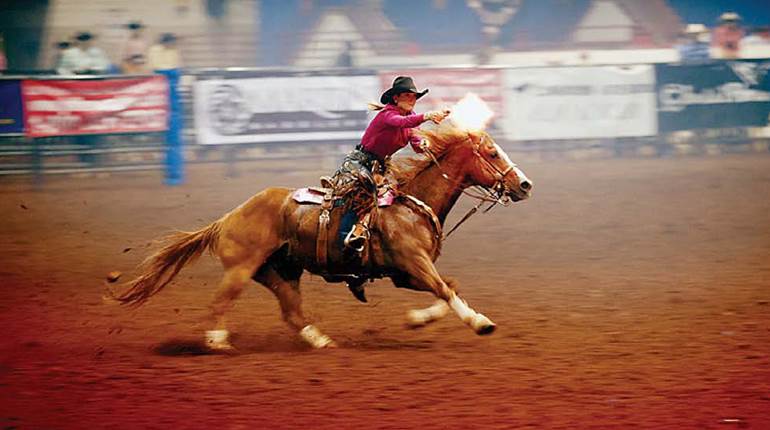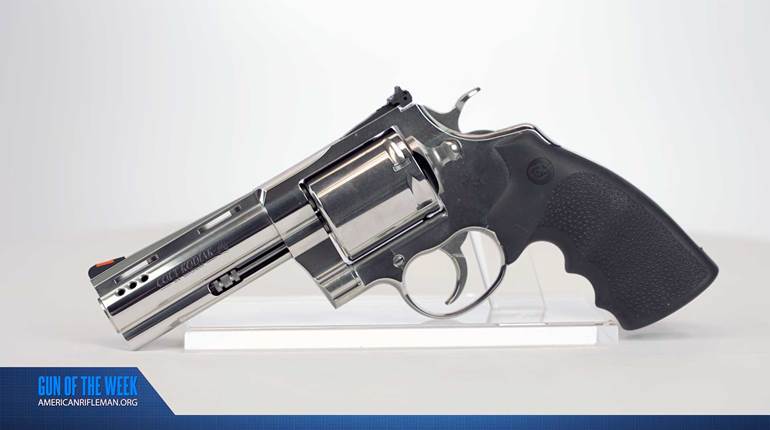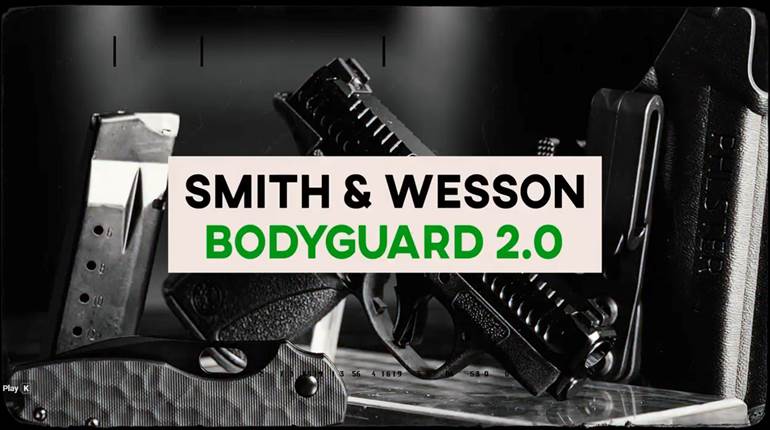
Mention the words “Smith & Wesson revolver,” and most of us immediately think of a five- or six-shot wheelgun with a swing-out cylinder and an under-barrel lug. But just as there are people today who have never known a world without computers, there was a time when this now-ubiquitous revolver shape simply didn’t exist. In fact, until the beginning of the last century, most handgun loading and unloading was done one cartridge at a time via a relatively slow, flip-open gate method, or by a multiple-cartridge top-break system, whereby the barrel pivoted on a hinge to extract or reload a cylinder full of cartridges.
Smith & Wesson dramatically changed all that with a progression of three aptly named .44 caliber “Hand Ejector” revolvers that introduced the now-familiar thumb latch that unlocked the cylinder from the frame and enabled it to swing out to the side. Then, a quick press of the attached ejector rod instantly popped out all six cartridges (or their empty casings). It was an ingenious system that we take for granted today, but it was revolutionary—in the most literal sense of the word—at the beginning of the 20th century.
 The Smith & Wesson Triple Lock is thought by many to be the epitome of what a modern double-action should look like—even though it first came out in 1908 and started the S&W .44 Hand Ejector trilogy, which lasted until World War II. This particular Triple Lock was one of the last produced and was shipped to businessman J.F. Darling on Sept. 11, 1915.
The Smith & Wesson Triple Lock is thought by many to be the epitome of what a modern double-action should look like—even though it first came out in 1908 and started the S&W .44 Hand Ejector trilogy, which lasted until World War II. This particular Triple Lock was one of the last produced and was shipped to businessman J.F. Darling on Sept. 11, 1915.
It all started in 1908 with Smith & Wesson’s innovative .44 Hand Ejector First Model, or as the company more stoically referred to it, the Smith & Wesson .44 Military Model of 1908. Today this gun is commonly known as the Triple Lock, arguably the most advanced—and in some ways the most over-engineered—handgun Smith & Wesson had ever produced. When introduced, this hefty handgun was simply catalogued as the .44 New Century, a name that was not only prompted by the then-recent turn of the last century, but also indicative of its exclusive pairing with a new cartridge, the S&W .44 Special.
 This is the yoke lock that made the Triple Lock so expensive. It was eliminated on subsequent Hand Ejector models.
This is the yoke lock that made the Triple Lock so expensive. It was eliminated on subsequent Hand Ejector models.
This loading was a slightly beefed-up evolution of the older .44 Smith & Wesson Russian, but with a more elongated case, thus permitting three more grains of blackpowder than the .44 Russian. Yes, the .44 Spl. originally started out as a blackpowder cartridge, as this was still during the transition years going from blackpowder to smokeless. But the .44 Spl. cartridge—and the gun for which it was designed, the Triple Lock—was obviously more than capable of handling smokeless powder loads. Nonetheless, and somewhat inexplicably, the Triple Lock was also chambered for the less powerful .44 Russian, although later, .38-40, .44-40, .45 Colt, and .455 Webley Mark II chamberings were offered. But it was the new .44 Spl. that garnered the spotlight and became the cartridge most closely associated with Triple Lock. After all, the gun was created for it.
 The S&W Second Model Hand Ejector eliminated the under-barrel shroud and the third lock and became the most prolific of all three .44 Hand Ejector models. This Second Model was shipped on April 27, 1929, to Neilson Radio & Sporting Goods in Phoenix, Ariz. One wonders what its purpose was in those early “Valley of the Sun” years in that portion of the still-untamed southwest.
The S&W Second Model Hand Ejector eliminated the under-barrel shroud and the third lock and became the most prolific of all three .44 Hand Ejector models. This Second Model was shipped on April 27, 1929, to Neilson Radio & Sporting Goods in Phoenix, Ariz. One wonders what its purpose was in those early “Valley of the Sun” years in that portion of the still-untamed southwest.
The Triple Lock’s name came from the fact that its cylinder locked up three different ways: with a spring-loaded catch between the end of the yoke and the tip of the extractor shroud, by a center pin indentation in the frame that secured the cylinder, and with another catch in front of the extractor. The Triple Lock was also the first Smith & Wesson to sport the now-familiar under-barrel shroud, which protected the extractor and put more weight in front of the frame, which aided accuracy. Barrel lengths were 4” 5” and 6.5”, and both fixed and adjustable target sight versions were offered. Finishes were either blued or nickeled and standard grips were checkered walnut.
 The S&W Second Model Hand Ejector was called into service during the Second World War and, along with the Colt New Service, became the Model 1917. Both guns were chambered for .45 ACP, which required the use of half-moon clips in order to use their extractors.
The S&W Second Model Hand Ejector was called into service during the Second World War and, along with the Colt New Service, became the Model 1917. Both guns were chambered for .45 ACP, which required the use of half-moon clips in order to use their extractors.
Not surprisingly, the Triple Lock’s three locking systems and its under-barrel lug made it an expensive gun to produce, which resulted in a price tag of $21—a sizable sum back in those days. Consequently, despite its refinements, sales were sluggish. In addition, with the outbreak of World War I, when both the British and Canadian governments began purchasing .455 Webley-chambered Triple Locks for their troops, they became concerned that the under-barrel shroud and its accompanying third locking mechanism—the most delicate feature of the gun—could collect debris and thus result in a malfunction. This resulted in the Triple Lock being discontinued by 1915, with only 15,375 guns produced—making it highly collectable today.
 Prior to the advent of the S&W Hand Ejector double actions, the one-cartridge-at-a-time loading gate method was in vogue, as seen here on this Colt Model 1878 double-action revolver.
Prior to the advent of the S&W Hand Ejector double actions, the one-cartridge-at-a-time loading gate method was in vogue, as seen here on this Colt Model 1878 double-action revolver.
In 1914, the Triple Lock .44 Hand Ejector First Model began to be replaced by the .44 Hand Ejector Second Model. The most prolific of all the Hand Ejector models, 34,624 guns were produced until its discontinuance in 1940. The Hand Ejector Second Model was essentially the same solid gun as the Triple Lock, but without the costly under barrel lug and omitting the locking point between the yoke tip and extractor shroud. Given the relatively underpowered loading of even the smokeless powder version of the .44 Spl., this third lock was rightfully deemed unnecessary. With a lowered initial price of $19, the Second Model proved to be immensely popular, especially in .44 Spl., and even though it was also offered in the same alternate calibers as the Triple Lock, those chamberings are extremely rare. As an example, only 565 Second Models were made in .44-40, and just 727 were in .45 Colt.
 Another early method of reloading a revolver was the top or bottom-break barrels, which permitted the cylinder to be removed, as shown here on this S&W No. 1, 3rd Model.
Another early method of reloading a revolver was the top or bottom-break barrels, which permitted the cylinder to be removed, as shown here on this S&W No. 1, 3rd Model.
Like the Triple Lock, the Second Model was produced with either a blued or nickeled finish, and both had a case-hardened hammer and trigger and checkered walnut grips. Barrel lengths were also 4”, 5” and 6.5”. Although the Second Model reigned supreme in S&W’s .44-cal. lineup, both civilian shooters and lawmen began clamoring for the return of the extractor-protecting under-barrel shroud (it seems no one missed the third cylinder lockup feature). Despite numerous letters and laments from dealers and gunwriters, Smith & Wesson ignored their pleas. That is, until Wolf & Klar, a popular Fort Worth, Texas, gun, jewelry and pawnshop and one of Smith & Wesson's biggest distributors, put in an order for 3,500 Second Model Hand Ejectors with the shroud. That got S&W’s attention.
 The final entrant in the S&W Hand Ejector trilogy was the .44 Hand Ejector Model of 1926. Thanks to pressure from Smith & Wesson distributor Wolf & Klar, it brought back the under-barrel shroud. This particular gun was shipped to Wolf & Klar on June 29, 1928; the buyer paid extra for the carved steer head pearl grips.
The final entrant in the S&W Hand Ejector trilogy was the .44 Hand Ejector Model of 1926. Thanks to pressure from Smith & Wesson distributor Wolf & Klar, it brought back the under-barrel shroud. This particular gun was shipped to Wolf & Klar on June 29, 1928; the buyer paid extra for the carved steer head pearl grips.
Thus, in 1926, the S&W Hand Ejector Third Model was born as an uncatalogued Wolf & Klar exclusive, with the same finishes, barrel lengths and calibers as the Second Model Hand Ejector, but with the much-demanded return of the barrel shroud. Ironically, only 1,000 Third Models were actually shipped to Wolf & Klar between 1926 and 1936, although the gun—which unofficially became known as the Wolf & Klar Model—could also be specially ordered directly from the factory. Many of the W&K-delivered guns were subsequently engraved (often crudely) by local artisans, sometimes replated with nickel, and could be fitted by Wolf & Klar with extra-cost pearl or ivory grips. But in total, just 4,976 Third Models were made between 1926 and 1940, when World War II halted production. Consequently, the relatively few guns shipped to Wolf & Klar carry a premium, and Wolf & Klar guns in general have become a popular sub-category of S&W .44 Hand Ejector collecting.

Although the Second and Third Model Hand Ejector revolvers were officially discontinued by the outbreak of World War II, the Second Model assumed a new identity for wartime use by our troops and their allies as the Smith & Wesson Model 1917, which featured a Parkerized finish, a shortened cylinder chambered in .45 ACP (extraction for the rimless .45 ACP casings was aided by half-moon clips) and affixed with a lanyard ring on the butt.
After the war, the former Third Model Hand Ejector replaced the Second Model completely, but became known as the Model of 1926, with the addition of a new hammer block safety. But whether a First, Second or Third Model Hand Ejector, for many, these graceful yet ruggedly configured sculptors in steel continue to represent the epitome of what a modern double-action revolver should look like, even though their basic design was conceived more than 100 years ago.





































